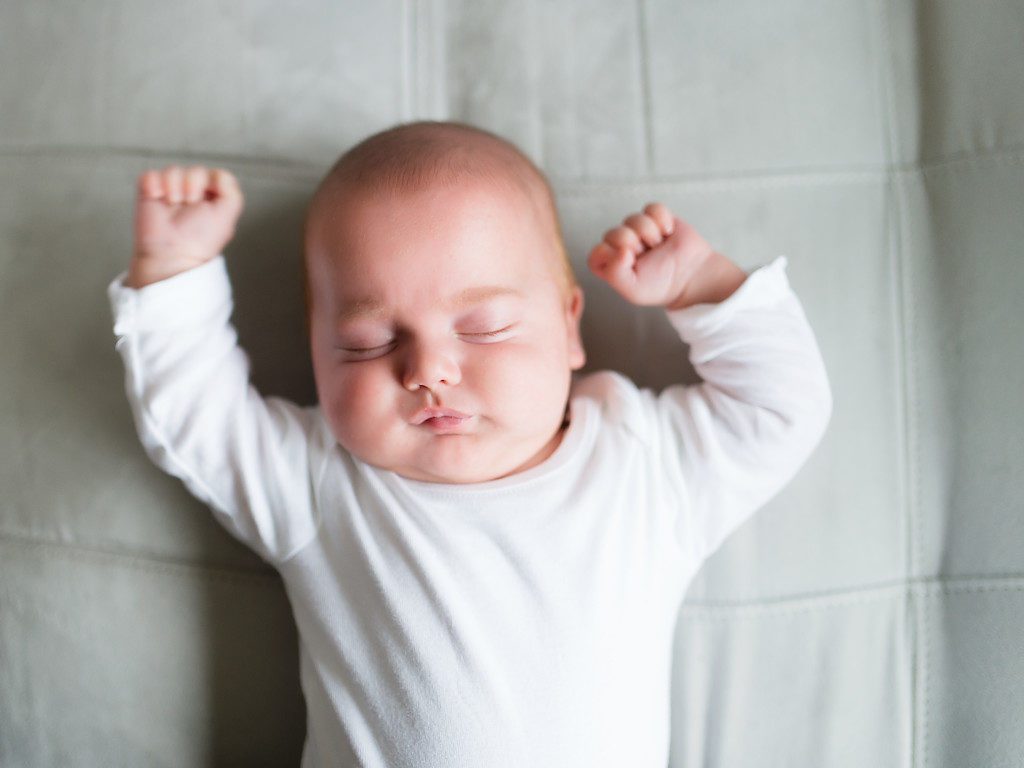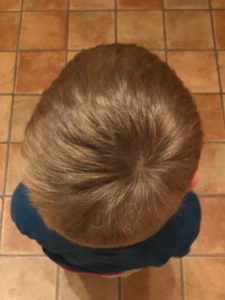
Our son was about 2 months old when I noticed that he had a flat head. It was jarring at first. It looked like his head had been dented in the back on the right side. I worried that some kind of an injury occurred that I was unaware of. However, upon closer inspection, I realized that what he had was simply a flat spot on the back of his head. While it was something I’d never seen before on an infant, I had read about flat head syndrome and I knew that it was a relatively common phenomenon since the introduction of the Back to Sleep Campaign.
A trip to the pediatricians office was very enlightening. Our son had congenital muscular torticollis, which meant that the sternocleidomastoid muscle in his neck was tight and shortened on the right side, which is why he preferred to only turn his head to the right; it was just more comfortable for him that way. This, in turn, caused plagiocephaly, 0r a flat spot, to form on his right occiput. He had what was considered a moderate deformity, meaning his ears had shifted out of alignment and he had a slight bulge in his forehead on the right side. He had no cheek, face or jaw deformity which would have classified his plagiocephaly as severe. In our situation, the problem stemmed from the way he was positioned in utero, having shared a small space with his twin sister.
We started physical therapy to work on correcting the underlying issue: his tight neck muscles. We had a weekly standing appointment where Frank received neck massage and was entertained with fun musical and light up toys to encourage him to turn his head his non-preferred way. We were taught exercises and massage techniques to use at home. We also upped our tummy time game at home and always tried to encourage him/trick him into turning his head towards the left. We rotated how we changed his diaper so that if he looked right, his preferred way, he was facing the wall, this motivated him to turn his head towards the left.
These treatments were improving the tight neck muscles, but we weren’t seeing much change in the flat spot on the back of his head. We were presented with the option of having a helmet fitted to aid in rounding out his head and eliminating the flat spot. We reviewed the scientific literature and we discussed it with the pediatrician and physical therapist. Helmeting is a bit of a polarizing topic. In our research, we found that with the most rigorous studies there was virtually no benefit of having worn a helmet. I’m specifically referencing a study published in the British Medical Journal in May of 2014. (It was Sept 2015 when we were having the conversation regarding helmeting so this study was very up to date at the time). The authors of the study performed a randomized, controlled clinical trial and found virtually no difference in outcome between helmeted and non-helmeted children at 2 years of age. Age two is when the cranial sutures in the skull typically fuse together.
We ultimately decided that there just wasn’t enough scientific evidence to justify having him wear a helmet. As a parent, however, you always worry whether you’re making the right choice. We worried that he would have a noticeable deformity for life that could lead to teasing. Having a child wear a helmet to treat plagiocephaly is a relatively simple thing that can make parents feel confident that they’re actively doing everything they can to correct the issue. Perhaps by choosing to helmet him we would have saved ourselves quite a bit of worry!
We continued with physical therapy and we also had a few appointments with a craniosacral therapist. We kept up our exercises at home and continued to reposition his head to the non-preferred side. Frank’s now four and I’m please to report that his previously moderate plagiocephaly is now very mild and not really noticeable. We’re relieved about this and really pleased with the course of action we chose.


My goal isn’t to sway parents one way or the other regarding helmeting in regards to plagiocephaly. That’s a decision that each family has to make based on their child’s individual situation. I simply hope to provide a little reassurance that if your situation is like ours, and you decide to not to helmet, and instead work to treat the underlying issue with physical therapy, chances are good that the child’s head will return to a normal shape.












This is an excellent article…and very well written. It provides the right information for parents to help them make a decision whether or not to helmet if faced with a flat spot on your child’s head.
Comments are closed.